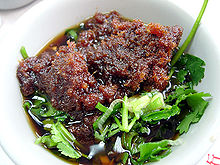Shacha sauce
 | |
| Place of origin | Chaozhou, China |
|---|---|
| Region or state | Chaoshan, Fujian, Taiwan |
Shacha sauce (Chinese: 沙茶; Pe̍h-ōe-jī: sa-te; also spelled sa cha sauce) is a savory, slightly spicy Chinese condiment used in Teochew, Fujian, and Taiwanese cuisines. It is made from soybean oil, garlic, shallots, chilis, Chinese brill, and dried shrimp.[1][2] It is also sometimes sold as "Chinese barbeque sauce".[3][4]
Shacha sauce is used many different ways; as a soup base, a barbeque meat rub, a dipping sauce (for hot pot), or a seasoning for stir-fries. It is also included with instant noodles manufactured in Vietnam, in their own packet alongside packets of soup base, dried vegetables, or other seasonings.[5]
Origin[]
Shacha sauce is also known as sa-te sauce in the Teochew and Hokkien dialects, reflecting its origin in the satay sauce introduced by expatriate Min Nan people returning to China from India. It is speculated that shacha sauce originated in the city of Chaozhou, Guangdong as an adaptation of Malaysian and Indonesian satay sauce. It is, however, quite different from the peanut-based satay sauce popular in Malaysia and Indonesia.[6]
See also[]
- List of Chinese sauces
- Siu haau sauce
- Peanut sauce
- XO sauce
- Shito - Similar condiment used in Ghana
References[]
- ^ Mary Kate Tate & Nate Tate (2011). Feeding the Dragon. Kansas City, Missouri, USA: Andrews McMeel Publishing Ltd. p. 270. ISBN 978-1-4494-0111-5. Retrieved 12 April 2012.
- ^ Acciardo, Kelli (2021-07-02). "Chefs Swear By These Under-the-Radar Asian Ingredients for Game-Changing Flavor". Parade: Entertainment, Recipes, Health, Life, Holidays. Retrieved 2021-09-26.
- ^ "How To Shop A Chinese Supermarket Like A Pro". LAist. 2020-01-24. Retrieved 2021-09-26.
- ^ Allen, Gary (2019-02-08). Sauces Reconsidered: Après Escoffier. Rowman & Littlefield. p. 102. ISBN 978-1-5381-1514-5.
- ^ "The secrets behind instant noodle seasoning sachets". VnExpress International. Retrieved 2021-09-26.
- ^ "Sacha Sauce Goes Out to All My Umami Lovers". Bon Appétit. Retrieved 2021-07-04.
- Chinese condiments
- Fujian cuisine
- Teochew cuisine
- Taiwanese cuisine
- Chinese sauces
- Barbecue sauces
- Condiment stubs
- Chinese cuisine stubs
